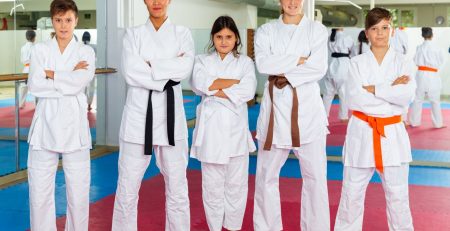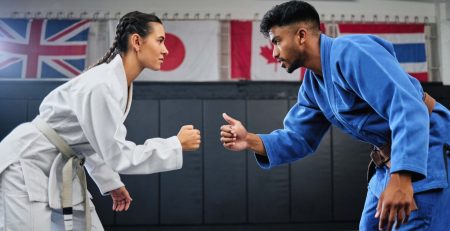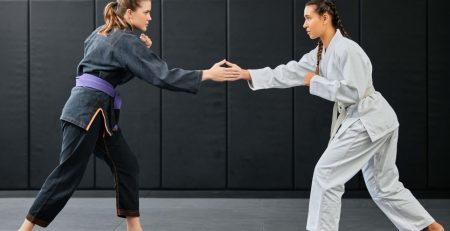Wing Chun vs Brazilian Jiu Jitsu – A Comparative Study
Table of Contents
- Introduction
- Origins and Philosophies
- Origin of Wing Chun
- Origin of Brazilian Jiu-Jitsu
- Fundamental Techniques
- Wing Chun Techniques
- Brazilian Jiu-Jitsu Techniques
- Training Methodologies
- Training in Wing Chun
- Training in Brazilian Jiu-Jitsu
- Practical Applications and Effectiveness
- Wing Chun in Real-World Scenarios
- Brazilian Jiu-Jitsu in Real-World Scenarios
- Competitive Landscapes
- Wing Chun in Competitions
- Brazilian Jiu-Jitsu in Competitions
- Self-Defense Efficacy
- Self-Defense in Wing Chun
- Self-Defense in Brazilian Jiu-Jitsu
- Cultural Impact and Popularity
- Wing Chun’s Cultural Influence
- Brazilian Jiu-Jitsu’s Cultural Influence
- Conclusion
1. Introduction
Martial arts have long been revered for their ability to improve physical fitness, discipline, and self-defense capabilities. Among the myriad of martial arts styles practiced worldwide, Wing Chun and Brazilian Jiu-Jitsu (BJJ) stand out due to their unique techniques and philosophies. While Wing Chun is a traditional Chinese martial art focusing on close-quarters combat and efficient striking, Brazilian Jiu-Jitsu, rooted in Japanese Judo and Jiu-Jitsu, emphasizes ground fighting and submission holds. This blog post aims to provide a comprehensive comparison of Wing Chun and Brazilian Jiu-Jitsu, delving into their origins, techniques, training methodologies, practical applications, competitive aspects, self-defense effectiveness, and cultural impact. By exploring these facets, we can better understand the strengths and limitations of each martial art and how they cater to different needs and preferences.
2. Origins and Philosophies
Origin of Wing Chun
Wing Chun is a traditional Chinese martial art that traces its origins back to the southern part of China during the late Qing Dynasty. According to legend, Wing Chun was developed by a Buddhist nun named Ng Mui, one of the legendary Five Elders who survived the destruction of the Shaolin Temple by the Qing government. Ng Mui is said to have created Wing Chun after witnessing a crane and a snake fighting, which inspired her to develop a system that utilized both hard and soft techniques. She later taught this martial art to a young woman named Yim Wing Chun, who used the techniques to defend herself from a local warlord. The style was subsequently named after her.
Wing Chun emphasizes efficiency, directness, and simplicity. Its philosophy is grounded in the concept of using minimal effort to achieve maximum effect. The art focuses on close-quarters combat, with practitioners employing rapid strikes, low kicks, and a strong emphasis on maintaining balance and stability. The centerline theory, which involves attacking and defending along the central axis of the body, is a fundamental principle of Wing Chun. This approach ensures that practitioners can effectively neutralize attacks and counter with precision. Additionally, Wing Chun places a strong emphasis on sensitivity and reflexes, training practitioners to respond instinctively to their opponent’s movements through exercises like Chi Sao (sticky hands).
Origin of Brazilian Jiu-Jitsu
Brazilian Jiu-Jitsu (BJJ) has its roots in Japanese Jiu-Jitsu and Judo, but it has evolved into a distinct martial art with its own unique identity. The art of BJJ was brought to Brazil by Mitsuyo Maeda, a prominent Japanese judoka and a student of Jigoro Kano, the founder of Judo. In the early 20th century, Maeda traveled to Brazil and began teaching Judo to a young man named Carlos Gracie. Carlos, along with his brothers, particularly Helio Gracie, adapted and refined the techniques they learned from Maeda, focusing on ground fighting and submissions. This evolution gave birth to what is now known as Brazilian Jiu-Jitsu.
BJJ’s philosophy revolves around the concept of leverage and technique over brute strength. It is designed to allow a smaller, weaker individual to defend themselves against a larger, stronger opponent. BJJ practitioners aim to take their opponents to the ground, where they can apply a variety of techniques, including joint locks, chokeholds, and positional control, to subdue them. The art emphasizes the importance of positional hierarchy, with practitioners striving to achieve dominant positions from which they can control and submit their opponents. This focus on ground fighting distinguishes BJJ from many other martial arts, making it a highly effective and practical form of self-defense.
3. Fundamental Techniques
Wing Chun Techniques
Wing Chun is renowned for its straightforward, efficient techniques that prioritize speed and accuracy. The art’s core techniques revolve around close-quarters combat, emphasizing rapid strikes, low kicks, and effective blocking and deflection. One of the most iconic techniques in Wing Chun is the chain punch (Lin Wan Kuen), which involves delivering a rapid series of straight punches aimed at the opponent’s centerline. This technique is designed to overwhelm the opponent with speed and precision, minimizing the chance for counterattacks.
Another fundamental technique in Wing Chun is the Pak Sao (slapping hand), which is used to deflect incoming strikes and create openings for counterattacks. The Pak Sao is often used in conjunction with other techniques, such as the Lop Sao (pulling hand), to control the opponent’s limbs and create opportunities for strikes. Wing Chun practitioners also utilize a variety of kicks, such as the low sidekick (Chum Kiu) and the oblique kick, which target the opponent’s lower body to disrupt their balance and mobility.
Chi Sao, or sticky hands, is a unique training exercise in Wing Chun that helps practitioners develop sensitivity and reflexes. During Chi Sao practice, two practitioners maintain constant contact with each other’s arms and engage in a flowing, continuous exchange of movements. This exercise trains practitioners to feel and respond to their opponent’s movements instinctively, allowing them to effectively counter and neutralize attacks in close-quarters combat.
Brazilian Jiu-Jitsu Techniques
Brazilian Jiu-Jitsu is characterized by its focus on ground fighting and submission techniques. The art’s core techniques include a variety of joint locks, chokeholds, and positional controls designed to neutralize and submit an opponent. One of the foundational positions in BJJ is the guard, where a practitioner on their back uses their legs to control their opponent’s movements and create opportunities for sweeps, submissions, and positional advancements. The guard can be further categorized into various types, such as the closed guard, open guard, and half guard, each with its own set of techniques and strategies.
Submission holds are a critical aspect of BJJ, with practitioners employing techniques such as the armbar, triangle choke, and rear-naked choke to force their opponents to submit. These techniques are designed to leverage the practitioner’s body mechanics to apply pressure to their opponent’s joints or cut off their blood flow, compelling them to concede defeat or risk injury. BJJ also emphasizes positional control, with practitioners seeking to achieve dominant positions such as the mount, side control, and back control. From these positions, they can maintain control over their opponent and execute submissions with greater ease.
Another key aspect of BJJ training is sparring, or rolling, which involves live, full-contact practice with resisting opponents. This hands-on approach allows practitioners to test their techniques in realistic scenarios, develop their timing and reflexes, and improve their overall grappling skills. The emphasis on practical application and adaptability makes BJJ a highly effective martial art for both self-defense and competitive sports. For a deeper understanding of Brazilian jiu jitsu theory and technique, explore our comprehensive guide Brazilian jiu jitsu theory and technique. Dive into the principles and intricacies of this martial art to enhance your knowledge and skills on the mat.
4. Training Methodologies
Training in Wing Chun
Training in Wing Chun is characterized by its focus on developing efficiency, sensitivity, and precision in close-quarters combat. Practitioners typically begin their training with the practice of fundamental forms, such as Siu Nim Tao (Little Idea), Chum Kiu (Seeking the Bridge), and Biu Jee (Thrusting Fingers). These forms serve as the foundation for all Wing Chun techniques, teaching practitioners the basic movements, stances, and principles of the art. Through repeated practice of these forms, students develop muscle memory, balance, and coordination.
A significant component of Wing Chun training is the practice of Chi Sao (sticky hands), an exercise that develops sensitivity and reflexes by maintaining constant contact with a partner’s arms. Chi Sao training helps practitioners learn to feel and respond to their opponent’s movements instinctively, allowing them to effectively counter and neutralize attacks in real-time. This exercise also emphasizes relaxation and fluidity, teaching practitioners to remain calm and composed under pressure.
Wing Chun training also incorporates various drills and partner exercises designed to develop striking, blocking, and trapping skills. Practitioners engage in drills such as Pak Sao (slapping hand) and Lop Sao (pulling hand) to improve their ability to deflect and control their opponent’s movements. Additionally, training with the wooden dummy (Muk Yan Jong) is a crucial aspect of Wing Chun practice. The wooden dummy is a training apparatus that allows practitioners to practice their techniques with precise angles and timing, helping to refine their skills and improve their overall combat effectiveness.
Training in Brazilian Jiu-Jitsu
Training in Brazilian Jiu-Jitsu is highly structured and emphasizes practical application through live sparring, or rolling. Practitioners typically begin their training with the study of fundamental techniques, such as positional control, escapes, and basic submissions. These foundational techniques are taught through a combination of drills, instructional classes, and partner exercises. As students progress, they learn more advanced techniques and strategies, gradually building a comprehensive skill set.
A core component of BJJ training is the concept of positional hierarchy, which prioritizes achieving and maintaining dominant positions over an opponent. Practitioners learn to transition between positions such as the guard, side control, mount, and back control, each offering specific advantages and opportunities for submissions. The emphasis on positional control ensures that practitioners can effectively manage and neutralize their opponent’s movements, creating opportunities to apply submissions and secure victory.
Sparring, or rolling, is an integral part of BJJ training. During sparring sessions, practitioners engage in live, full-contact practice with resisting opponents, allowing them to test their techniques and strategies in realistic scenarios. This hands-on approach helps students develop their timing, reflexes, and adaptability, making them more effective grapplers. Additionally, rolling fosters a deep understanding of body mechanics and leverage, essential principles in BJJ that enable practitioners to overcome larger and stronger opponents.
Another key aspect of BJJ training is the use of the gi, a traditional uniform that facilitates grips and control. Practitioners learn to utilize the gi to enhance their techniques, such as gripping the opponent’s collar or sleeves to apply submissions and positional controls. No-gi training, which is practiced without the traditional uniform, emphasizes speed and adaptability, requiring practitioners to rely on different grips and techniques. Both gi and no-gi training are essential components of BJJ, offering unique challenges and opportunities for growth. Learn more about Brazilian jiu jitsu training techniques and methods in our comprehensive guide Brazilian jiu jitsu training.
5. Practical Applications and Effectiveness
Wing Chun in Real-World Scenarios
Wing Chun’s practical application in real-world scenarios lies in its focus on efficiency, directness, and close-quarters combat. The art is designed to neutralize threats quickly and effectively, making it well-suited for self-defense situations. One of the key strengths of Wing Chun is its emphasis on the centerline theory, which involves attacking and defending along the central axis of the body. This approach ensures that practitioners can deliver powerful, precise strikes while minimizing their exposure to counterattacks.
In real-world scenarios, Wing Chun practitioners are trained to respond instinctively to an opponent’s movements, using techniques such as chain punches, low kicks, and trapping hands to overwhelm and incapacitate their attackers. The rapid, continuous nature of Wing Chun’s strikes allows practitioners to maintain the initiative, preventing their opponents from mounting an effective defense. Additionally, Wing Chun’s focus on economy of movement and minimal force means that practitioners can conserve energy and remain effective even in prolonged encounters.
One of the unique aspects of Wing Chun is its ability to adapt to various self-defense situations. The art’s emphasis on sensitivity and reflexes, developed through exercises like Chi Sao, enables practitioners to respond to attacks with fluidity and precision. This adaptability makes Wing Chun effective in confined spaces, such as narrow hallways or crowded areas, where larger movements may be impractical. Furthermore, Wing Chun’s techniques can be applied against multiple attackers, allowing practitioners to defend themselves in complex, high-pressure scenarios.
Brazilian Jiu-Jitsu in Real-World Scenarios
Brazilian Jiu-Jitsu’s practical application in real-world scenarios is rooted in its focus on ground fighting and submission techniques. The art’s core principles of leverage, technique, and positional control enable practitioners to neutralize larger and stronger opponents, making BJJ a highly effective form of self-defense. One of the key strengths of BJJ is its emphasis on taking the fight to the ground, where practitioners can apply joint locks, chokeholds, and positional controls to subdue their attackers.
In real-world scenarios, BJJ practitioners are trained to close the distance with their opponents, initiate takedowns, and control the fight from the ground. The art’s extensive repertoire of submission holds, such as the armbar, triangle choke, and rear-naked choke, allows practitioners to incapacitate their opponents without relying on strikes. This focus on grappling and submissions makes BJJ particularly effective in situations where striking may be impractical or undesirable, such as when defending against a larger attacker or in environments where striking could cause collateral damage.
BJJ’s emphasis on live sparring and practical application ensures that practitioners are well-prepared for real-world encounters. The hands-on nature of BJJ training develops a deep understanding of body mechanics, leverage, and timing, enabling practitioners to respond effectively to dynamic, unpredictable situations. Additionally, BJJ’s focus on positional control and escapes ensures that practitioners can defend themselves from various positions, whether they are on their back, in a dominant position, or in a vulnerable situation.
While BJJ excels in one-on-one encounters and ground fighting scenarios, it may be less effective in situations involving multiple attackers or when a quick resolution is required. However, the principles and techniques of BJJ can be adapted to complement other martial arts, providing practitioners with a well-rounded self-defense skill set.
Looking to explore martial arts further? Check out these articles for more insights: Brazilian Jiu Jitsu vs Muay Thai for a comparison between two popular disciplines.
6. Competitive Landscapes
Wing Chun in Competitions
Wing Chun’s presence in competitive martial arts is relatively limited compared to other styles, primarily due to its focus on self-defense and real-world applicability rather than sport. Traditional Wing Chun training emphasizes practical techniques designed to neutralize threats quickly and efficiently, which may not align with the rules and regulations of many martial arts competitions. However, Wing Chun practitioners can still participate in various forms of competitive fighting, such as point-based sparring, kickboxing, and mixed martial arts (MMA), where they can showcase their striking and close-quarters combat skills.
In point-based sparring competitions, Wing Chun practitioners can leverage their speed, precision, and direct striking techniques to score points against their opponents. The rapid chain punches and low kicks characteristic of Wing Chun can be effective in these settings, allowing practitioners to land clean, decisive strikes. However, the lack of emphasis on grappling and ground fighting may be a disadvantage in competitions that allow a wider range of techniques.
Wing Chun’s effectiveness in kickboxing and MMA competitions can vary depending on the practitioner’s ability to adapt their techniques to the specific rules and context of the sport. In kickboxing, Wing Chun practitioners can utilize their striking skills, but they may need to modify their techniques to accommodate the longer range and dynamic movement common in kickboxing matches. In MMA, where a broader range of techniques is permitted, Wing Chun practitioners may need to supplement their training with additional grappling and ground fighting skills to remain competitive.
Brazilian Jiu-Jitsu in Competitions
Brazilian Jiu-Jitsu has a well-established competitive landscape, with numerous tournaments and competitions held worldwide. BJJ competitions typically involve gi and no-gi divisions, where practitioners compete in matches to showcase their grappling skills, positional control, and submission techniques. The sport’s emphasis on live sparring and practical application ensures that BJJ practitioners are well-prepared for competitive scenarios, making BJJ one of the most popular and respected martial arts in the competitive arena.
In BJJ competitions, matches are often won through points awarded for achieving and maintaining dominant positions, performing successful sweeps, and applying submission holds. The point system encourages practitioners to focus on positional control and technical proficiency, rewarding those who can effectively control their opponents and execute clean, precise techniques. The extensive repertoire of submissions in BJJ, such as armbars, chokes, and leg locks, adds an additional layer of strategy and excitement to competitive matches.
No-gi competitions, which are practiced without the traditional uniform, emphasize speed, agility, and adaptability. No-gi BJJ requires practitioners to rely on different grips and techniques, often making the matches faster-paced and more dynamic. This variation of BJJ competitions highlights the art’s versatility and the importance of adapting techniques to different contexts.
BJJ’s presence in mixed martial arts (MMA) competitions has also contributed to its widespread popularity. Many successful MMA fighters have a strong background in BJJ, utilizing their grappling and submission skills to dominate opponents in the cage. The effectiveness of BJJ in MMA has cemented its reputation as a practical and versatile martial art, capable of neutralizing opponents through superior ground control and submissions.
7. Self-Defense Efficacy
Self-Defense in Wing Chun
Wing Chun’s efficacy in self-defense scenarios is rooted in its focus on close-quarters combat, efficiency, and practicality. The art’s emphasis on the centerline theory, rapid strikes, and economy of movement makes it well-suited for neutralizing threats quickly and effectively. Wing Chun practitioners are trained to respond instinctively to an opponent’s movements, using techniques such as chain punches, low kicks, and trapping hands to overwhelm and incapacitate their attackers.
One of the key strengths of Wing Chun in self-defense is its ability to adapt to various situations and environments. The art’s techniques are designed to be effective in confined spaces, such as narrow hallways or crowded areas, where larger movements may be impractical. Wing Chun’s focus on sensitivity and reflexes, developed through exercises like Chi Sao, enables practitioners to respond to attacks with fluidity and precision, making it effective against multiple attackers and in high-pressure scenarios.
The simplicity and directness of Wing Chun techniques also contribute to its effectiveness in self-defense. Practitioners are trained to use minimal force to achieve maximum effect, allowing them to conserve energy and remain effective even in prolonged encounters. The art’s emphasis on maintaining balance and stability ensures that practitioners can control their movements and avoid being easily thrown off balance by their opponents.
Self-Defense in Brazilian Jiu-Jitsu
Brazilian Jiu-Jitsu’s efficacy in self-defense scenarios is primarily based on its focus on ground fighting, leverage, and submission techniques. The art’s core principles enable practitioners to neutralize larger and stronger opponents by taking the fight to the ground and applying joint locks, chokeholds, and positional controls. BJJ’s emphasis on practical application through live sparring ensures that practitioners are well-prepared for real-world encounters, making it a highly effective form of self-defense.
In self-defense situations, BJJ practitioners are trained to close the distance with their opponents, initiate takedowns, and control the fight from the ground. The art’s extensive repertoire of submissions allows practitioners to incapacitate their attackers without relying on strikes, which can be advantageous in situations where striking may be impractical or undesirable. BJJ’s focus on positional control and escapes ensures that practitioners can defend themselves from various positions, whether they are on their back, in a dominant position, or in a vulnerable situation.
While BJJ excels in one-on-one encounters and ground fighting scenarios, it may be less effective in situations involving multiple attackers or when a quick resolution is required. However, the principles and techniques of BJJ can be adapted to complement other martial arts, providing practitioners with a well-rounded self-defense skill set. Interested in learning how Brazilian jiu jitsu can be applied for self-defense? Our article on Brazilian jiu jitsu self defense explores the practical techniques and strategies that make BJJ an effective martial art for real-world situations.
8. Cultural Impact and Popularity
Wing Chun’s Cultural Influence
Wing Chun has had a significant cultural impact, particularly within the realm of Chinese martial arts and popular culture. The art’s association with legendary martial artists such as Ip Man and Bruce Lee has contributed to its widespread recognition and popularity. Ip Man, a renowned Wing Chun master, played a pivotal role in popularizing the art in the 20th century, and his life story has been immortalized in numerous films and television series. Bruce Lee, a student of Ip Man, further elevated Wing Chun’s status by incorporating its principles into his own martial art, Jeet Kune Do, and by showcasing its techniques in his movies.
Wing Chun’s influence extends beyond the realm of martial arts, permeating popular culture through films, television, and literature. The Ip Man film series, starring Donnie Yen, has brought Wing Chun to a global audience, inspiring many to take up the practice. The art’s portrayal in these films highlights its practical effectiveness, simplicity, and directness, contributing to its appeal as a self-defense system.
Brazilian Jiu-Jitsu’s Cultural Influence
Brazilian Jiu-Jitsu has had a profound cultural impact, particularly within the world of mixed martial arts (MMA) and combat sports. The art’s effectiveness in real-world scenarios and competitive arenas has cemented its reputation as a practical and versatile martial art. The rise of the Ultimate Fighting Championship (UFC) in the 1990s, featuring BJJ practitioners like Royce Gracie, showcased the art’s dominance in the early days of MMA, contributing to its global popularity.
BJJ’s influence extends beyond the competitive realm, permeating popular culture through films, television, and literature. The art’s portrayal in movies like “Warrior” and television series like “Kingdom” has introduced its techniques and principles to a broader audience. BJJ’s focus on leverage, technique, and positional control resonates with many, inspiring individuals from diverse backgrounds to take up the practice.
The cultural impact of BJJ is also evident in its global community and the proliferation of BJJ academies worldwide. The art’s emphasis on mutual respect, discipline, and continuous learning fosters a sense of camaraderie and inclusivity among practitioners. This supportive and collaborative environment has contributed to the growth and popularity of BJJ, making it one of the most widely practiced martial arts globally.
- Dive into the differences between Brazilian Jiu Jitsu and Japanese Jiu Jitsu with our article Brazilian Jiu Jitsu vs Japanese Jiu Jitsu.
- Interested in Aikido? Discover how it differs from Brazilian Jiu Jitsu in our article Aikido vs Brazilian Jiu Jitsu.
9. Conclusion
In the eternal debate of Wing Chun vs. Brazilian Jiu-Jitsu, there is no definitive winner. Each martial art possesses unique strengths catering to different self-defense scenarios and personal preferences. Wing Chun excels in close-quarters combat, emphasizing rapid strikes, efficiency, and practicality. Its techniques are well-suited for confined spaces and high-pressure situations, making it an effective self-defense system. On the other hand, Brazilian Jiu-Jitsu specializes in ground fighting, leveraging techniques, and submissions. Its focus on positional control and practical application through live sparring makes it highly effective in one-on-one encounters and competitive arenas.
The choice between Wing Chun and Brazilian Jiu-Jitsu ultimately depends on individual goals, preferences, and the specific context one anticipates. For comprehensive self-defense, considering elements from both disciplines can offer a well-rounded skill set, ensuring adaptability in any circumstance. The effectiveness lies not in choosing one over the other but in understanding when and how to apply the right techniques for the right situation, ensuring the ability to adapt and prevail when it matters most.
FAQs: Wing Chun vs Brazilian Jiu-Jitsu
Q1: What are the main differences between Wing Chun and Brazilian Jiu-Jitsu?
A1: Wing Chun and Brazilian Jiu-Jitsu (BJJ) are distinct martial arts with unique focuses and techniques. Wing Chun is a traditional Chinese martial art that emphasizes close-quarters combat, rapid strikes, and centerline control. Its techniques are designed for quick and efficient self-defense, making it effective in confined spaces. BJJ, on the other hand, is a grappling martial art that originated from Judo and Japanese jiu-jitsu. It focuses on ground fighting, leveraging techniques, and submissions, making it highly effective in one-on-one encounters and competitive scenarios.
Q2: Which martial art is better for self-defense: Wing Chun or BJJ?
A2: Both Wing Chun and BJJ have strengths that make them effective for self-defense, depending on the situation. Wing Chun is excellent for close-quarters combat and quick, direct strikes, making it suitable for scenarios where rapid resolution is necessary. BJJ excels in ground fighting and submissions, allowing practitioners to neutralize larger opponents through leverage and positional control. The best choice depends on personal preferences and the specific context of the self-defense scenario. Combining elements from both arts can provide a well-rounded self-defense skill set.
Q3: How does training in Wing Chun differ from training in BJJ?
A3: Training in Wing Chun focuses on sensitivity, timing, and precision. Practitioners engage in exercises like Chi Sao (sticky hands) to develop reflexes and control in close-quarters combat. Training includes drills for striking, trapping, and maintaining balance. BJJ training emphasizes live sparring (rolling), where practitioners engage in full-contact practice with resisting opponents. BJJ practitioners learn techniques for takedowns, joint locks, and chokeholds, both with and without the traditional gi uniform. The hands-on nature of BJJ training develops a deep understanding of body mechanics and leverage.
Q4: Can Wing Chun be effective in mixed martial arts (MMA) competitions?
A4: Wing Chun can be effective in MMA competitions if practitioners adapt their techniques to the specific rules and context of the sport. Wing Chun’s rapid strikes and close-quarters combat skills can be advantageous, but practitioners may need to supplement their training with grappling and ground fighting techniques to remain competitive in MMA. Success in MMA often requires a well-rounded skill set, combining striking, grappling, and submission techniques.
Q5: How has BJJ influenced modern mixed martial arts (MMA)?
A5: BJJ has had a significant impact on modern MMA, particularly due to its effectiveness in early UFC competitions. Practitioners like Royce Gracie showcased the dominance of BJJ’s ground fighting and submission techniques, establishing its reputation as a practical and versatile martial art. BJJ’s principles of leverage, positional control, and submissions are now integral components of MMA training, with many successful fighters having strong backgrounds in BJJ.
Q6: What are the benefits of practicing Wing Chun?
A6: Practicing Wing Chun offers several benefits, including improved reflexes, sensitivity, and timing. The art’s focus on close-quarters combat and economy of movement enhances self-defense skills, making practitioners effective in confined spaces and high-pressure situations. Wing Chun training also develops balance, coordination, and mental focus, contributing to overall physical and mental well-being.
Q7: What are the benefits of practicing Brazilian Jiu-Jitsu?
A7: Practicing Brazilian Jiu-Jitsu provides numerous benefits, such as improved physical fitness, flexibility, and strength. BJJ training enhances problem-solving skills, as practitioners must think strategically to apply techniques and control opponents. The art’s emphasis on live sparring develops practical self-defense skills and a deep understanding of body mechanics and leverage. Additionally, BJJ fosters a sense of camaraderie and mutual respect among practitioners, contributing to a supportive and inclusive community.
Q8: Is it beneficial to train in both Wing Chun and BJJ?
A8: Training in both Wing Chun and BJJ can be highly beneficial, as it provides a comprehensive self-defense skill set. Wing Chun’s striking and close-quarters combat techniques complement BJJ’s grappling and ground fighting skills, offering practitioners versatility in various scenarios. Combining elements from both arts ensures adaptability and the ability to handle a wide range of self-defense situations effectively.
Q9: How long does it take to become proficient in Wing Chun and BJJ?
A9: The time required to become proficient in Wing Chun and BJJ varies depending on the individual’s dedication, training frequency, and natural aptitude. Typically, it can take several years of consistent practice to achieve a high level of proficiency in either art. Wing Chun practitioners may see significant improvements in their striking and reflexes within a few years, while BJJ practitioners often progress through a belt system, with each belt representing a higher level of skill and knowledge. Both arts require continuous learning and practice to maintain and enhance proficiency.
Q10: Are there any notable practitioners of Wing Chun and BJJ?
A10: Notable Wing Chun practitioners include Ip Man, Bruce Lee, and Donnie Yen. Ip Man played a pivotal role in popularizing Wing Chun in the 20th century, and his student, Bruce Lee, incorporated Wing Chun principles into his own martial art, Jeet Kune Do. Donnie Yen, a renowned martial artist and actor, has portrayed Ip Man in several films, further popularizing Wing Chun.














Leave a Reply
You must be logged in to post a comment.